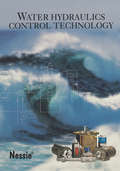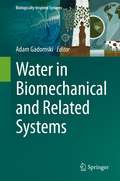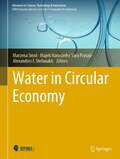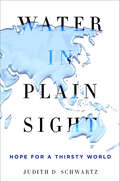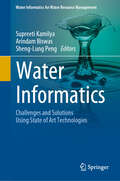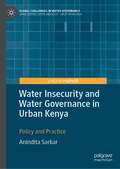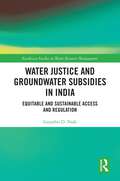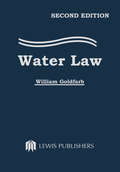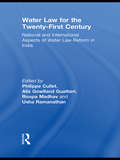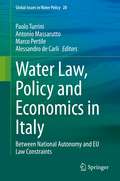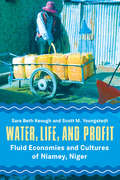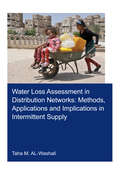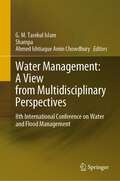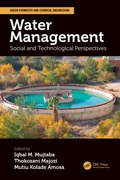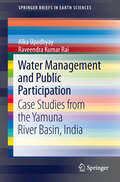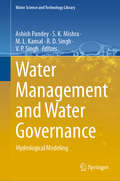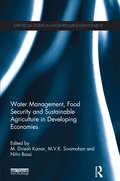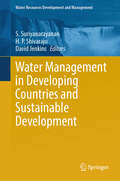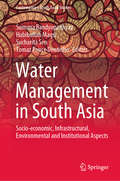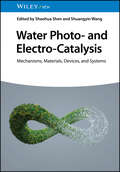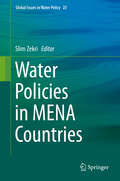- Table View
- List View
Water Hydraulics Control Technology
by Erik TrostmannThis work introduces the principles of water hydraulics technology and its benefits and limitations, and clarifies the essential differences between water and oil hydraulics. It discusses basic components and systems, including hydraulic power generators (pumps), hydraulic control components or modulators (valves), hydraulic transmission lines (tubes, hoses and fittings) and hydraulic actuators (single- or double-acting cylinders and rotary motors). A listing of water hydraulics components/systems manufacturers is provided.
Water in Biomechanical and Related Systems (Biologically-Inspired Systems #17)
by Adam GadomskiThe contributed volume puts emphasis on a superior role of water in (bio)systems exposed to a mechanical stimulus. It is well known that water plays an extraordinary role in our life. It feeds mammalian or other organism after distributing over its whole volume to support certain physiological and locomotive (friction-adhesion) processes to mention but two of them, both of extreme relevance.Water content, not only in the mammalian organism but also in other biosystems such as whether those of soil which is equipped with microbiome or the ones pertinent to plants, having their own natural network of water vessels, is always subjected to a force field.The decisive force field applied to the biosystems makes them biomechanically agitated irrespective of whether they are subjected to external or internal force-field conditions. It ought to be noted that the decisive mechanical factor shows up in a close relation with the space-and-time scale in which it is causing certain specific phenomena to occur.The scale problem, emphasizing the range of action of gravitational force, thus the millimeter or bigger force vs. distance scale, is supposed to enter the so-called macroscale approach to water transportation through soil or plants’ roots system. It is merely related to a percolation problem, which assumes to properly inspect the random network architecture assigned to the biosystems invoked. The capillarity conditions turn out to be of prior importance, and the porous-medium effect has to be treated, and solved in a fairly approximate way.The deeper the scale is penetrated by a force-exerting and hydrated agent the more non-gravitational force fields manifest. This can be envisaged in terms of the corresponding thermodynamic (non-Newtonian) forces, and the phenomena of interest are mostly attributed to suitable changes of the osmotic pressure. In low Reynolds number conditions, thus in the (sub)micrometer distance-scale zone, they are related with the corresponding viscosity changes of the aqueous, e.g. cytoplasmatic solutions, of semi-diluted and concentrated (but also electrolytic) characteristics. For example, they can be observed in articulating systems of mammals, in their skin, and to some extent, in other living beings, such as lizards, geckos or even insects. Through their articulating devices an external mechanical stimulus is transmitted from macro- to nanoscale, wherein the corresponding osmotic-pressure conditions apply.The content of the proposed work can be distributed twofold. First, the biomechanical mammalian-type (or, similar) systems with extraordinary relevance of water for their functioning will be presented, also including a presentation of water itself as a key physicochemical system/medium. Second, the suitably chosen related systems, mainly of soil and plant addressing provenience, will be examined thoroughly. As a common denominator of all of them, it is proposed to look at their hydrophobic and/or (de)hydration effects, and how do they impact on their basic mechanical (and related, such as chemo-mechanical or piezoelectric, etc.) properties. An additional tacit assumption employed throughout the monograph concerns statistical scalability of the presented biosystems which is equivalent to take for granted a certain similarity between local and global system’s properties, mostly those of mechanical nature. The presented work’s chapters also focus on biodiversity and ecological aspects in the world of animals and plants, and the related systems. The chapters’ contents underscore the bioinspiration as the key landmark of the proposed monograph.
Water in Circular Economy (Advances in Science, Technology & Innovation)
by Marzena Smol Majeti Narasimha Vara Prasad Alexandros I. StefanakisThis book presents possible solutions for a circuler economy (CE) in the water and wastewater sector through an inventory of multidisciplinary knowledge with high scientific and practical importance which can contribute to support the transition to the CE model in water and wastewater sector. Water in modern studies exceeds being an important source for irrigation and drinking. It is now a significant source of renewable energy and a catalyst in most industrial and manufacturing products. The protection and sustainable management of water resources and water-based waste (as wastewater, sewage sludge, or sewage sludge ash) are important aspects of the CE, which is defined as a regenerative growth model that gives back to the planet more than it takes. Our book, entitled "Water in Circular Economy", delivers a comprehensive overview of the latest research covering the following aspects of water management from the perspective of the CE implementation: · Water as a key resource in the circular economy; · Innovative solutions in transition to the circular economy in water and wastewater sector; · Monitoring of circular economy implementation in water and wastewater sector.
Water in Lithium-Ion Batteries (SpringerBriefs in Energy)
by Futoshi Matsumoto Takao GunjiThis book reviews the impact of water content in lithium-ion batteries (LIBs) as well as the reactivity of anodes, cathodes and electrolytes with water and processes that provide water-resistance to materials in LIBs. Water in LIBs which were constructed with anode, cathode and organic electrolyte containing lithium salts can degrade the cell performance and seriously damage the materials present. However, because a small amount of water in cells contributes to the formation of the solid electrolyte interphase, complete removal of water from cells lowers the battery performance and increases costs due to removal of water from the battery materials. This book presents the optimal concentration of water for each battery material along with appropriate removal methods and water-scavengers which were developed recently to establish both high performance and lower costs. Moreover this book describes the development of anodes and cathodes prepared by aqueous process and aqueous LIBs in which aqueous electrolytes containing lithium salts are used as an electrolyte. This book will be useful not only for academic researchers but also for company researchers who deal with LIBs.
Water in Plain Sight: Hope for a Thirsty World
by Judith D. SchwartzWater scarcity is on everyone's mind. Long taken for granted, water availability has entered the realm of economics, politics, and people's food and lifestyle choices. But as anxiety mounts - even as a swath of California farmland has been left fallow and extremist groups worldwide exploit the desperation of people losing livelihoods to desertification - many are finding new routes to water security with key implications for food access, economic resilience, and climate change.Water does not perish, nor require millions of years to form as do fossil fuels. However, water is always on the move. In this timely, important book, Judith D. Schwartz presents a refreshing perspective on water that transcends zero-sum thinking. By allying with the water cycle, we can revive lush, productive landscapes. Like the river in rural Zimbabwe that, thanks to restorative grazing, now flows miles further than in living memory. Or the food forest of oranges, pomegranates, and native fruit-bearing plants in Tucson, grown through harvesting urban wastewater. Or the mini-oasis in West Texas nourished by dew.Animated by stories from around the globe, Water In Plain Sight is an inspiring reminder that fixing the future of our drying planet involves understanding what makes natural systems thrive.
Water Informatics: Challenges and Solutions Using State of Art Technologies (Water Informatics for Water Resource Management)
by Arindam Biswas Sheng-Lung Peng Supreeti KamilyaThis book provides a clear view of various applications for water resource management using different state-of-the-art technologies such as artificial intelligence, IoT, and cellular automata. The book also shows the analytical part of surface water as well as groundwater bodies to control pollution and save ecology. It gives an idea about the collection of data for disaster management such as flood prediction and flood inoculation. The book provides the fundamental aspects of various computational or simulation methods for surface and underground water body detection, prediction of non-biodegradable elements in water bodies, water potability, and predictions of natural disasters like floods. The book summarizes different aspects of water body challenges and the possible solutions proposed using new technologies. The book opens up a future research direction of dealing with various challenges and solutions based on emerging technologies. This book comes up with a direction for the researchers interested in dealing with various aspects of water challenges and finding solutions using emerging technologies in the new era of modern computations.
Water Insecurity and Water Governance in Urban Kenya: Policy and Practice (Global Challenges in Water Governance)
by Anindita SarkarThis book explores water service provisions of the urban poor in the cities of Africa with particular emphasis on Kenya and its capital city of Nairobi. In particular the book addresses the insecurity of tenure, and how the colonial segregation of land continues to shape water access and service provision even today in Nairobi. The book seeks to understand how urban water management entails the “production of thirst” among the urban poor and documents how cultural norms, political commitments and seemingly mundane practices of water managers combine to exclude the poor from accessing water. Supporters of privatization argue that private companies may succeed where governments have failed in supplying water to the urban poor. The author takes a closer look at this argument, demonstrating the limitations of some of the current reforms whilst also exploring alternatives and solutions. This book will be an invaluable reference for students, researchers and practitioners working in this field.
Water Justice and Groundwater Subsidies in India: Equitable and Sustainable Access and Regulation (Earthscan Studies in Water Resource Management)
by Gayathri D. NaikThis book examines the impact of water-related subsidies on social and distributive equity and environmental sustainability in groundwater access and regulation in India.This book argues that adopting a water justice framework is essential to ensure equitable and sustainable access to and regulation of groundwater by balancing anthropogenic and ecological water needs. The inherent inequity resulting from property rights-controlled groundwater access gets widened by the social, political, and economic factors determining the subsidy beneficiaries. Adopting a socio-legal approach, this book draws on two contrasting case studies in India: Kerala, a water-secure state, and Rajasthan, an arid state. Arguing for a shift to a new paradigm in water governance, it critically examines the feasibility of the public trust doctrine and rights of nature discourse to analyse the best suitable regulatory framework that can balance the human right to water and ecological sustainability in groundwater resources. It demonstrates the feasibility of adopting various environmental law principles that balance human rights to water and nature. It argues that the hitherto highlighted public trust doctrine cannot address these inequities due to its anthropogenic bias and property rights link. This book examines the applicability of the rights of nature discourse instead of these property rights-based regulations to incorporate and mainstream the concerns of aquifer protection in water governance.This book shall be of great interest to students, scholars, and practitioners of water law and policy, environmental law, water and social justice, development studies, and political ecology.
Water Law
by William GoldfarbThis revised second edition is essential to everyone involved with water and water resources-complying with the myriad federal, state, and local laws and regulations that govern the use and management of water in our attempts to maintain, clean, usable water. It includes the law of water diversion and distribution; water resources development and protection; water treatment and land use; ocean dumping; oil and hazardous substances cleanup; riparian and non-riparian systems; Eastern permit systems; beneficial use; water codes; prior appropriation; surface and ground water; channel modifications; municipal water supply; irrigation; California Water Management Districts; Bureau of Reclamation; Corps of Engineers; Water Resources Development Act of 1986; SCS, TVA, BPA, NEA, CERCLA, CWA, SDWA, RCRA, and their substantial changes in the last four years; water resources planning and research; public use; ownership of beds and banks; wild and scenic rivers; river corridor and instream flow protection; flood insurance, Section 404 and Section 208; the Supreme Court and water conservation; heat dischargers; quality-based effluent limitations; state ground water programs; pretreatment; funding; enforcement; citizen suits; and many more vital topics.
Water Law for the Twenty-First Century: National and International Aspects of Water Law Reform in India
by Philippe Cullet Alix Gowlland-Gualtieri Roopa Madhav Usha RamanathanIn the face of growing freshwater scarcity, most countries of the world are taking steps to conserve their water and foster its sustainable use. Water crises range from concerns of drinking water availability and/or quality, the degradation or contamination of freshwater, and the allocation of water to different users. To meet the challenge, many countries are undergoing systemic changes to the use of freshwater and the provision of water services, thereby leading to greater commercialization of the resource as well as a restructuring of the legal, regulatory, technical and institutional frameworks for water. The contributions to this book critically analyse legal issues arising under international law, such as environment and human rights provisions, concerning the economic, environmental and social consequences of proposed water regulatory changes and their implementation at the national level. The book examines the situation in India which is currently in the midst of implementing several World Bank led water restructuring projects which will have significant impacts on the realisation of the right to water and all other aspects of water regulation for decades to come. In analysing the situation in India the volume is able to detail the interactions between international law and national law in the field of water, and to ask broader questions about the compliance with international law at the national level and the relevance of international law in national law and policy-making.
Water Law, Policy and Economics in Italy: Between National Autonomy and EU Law Constraints (Global Issues in Water Policy #28)
by Paolo Turrini Antonio Massarutto Marco Pertile Alessandro De CarliThis book provides the first comprehensive overview of the most important water-related issues that centre on Italy, analysed from several disciplinary perspectives – such as hydrology, economics, law, sociology, environmental sciences and policy studies – in order to promote full understanding of the challenges the country is facing and the ways it could best tackle them.Despite the misconception that Italy is a water-scarce country, is in fact quite rich in water resources. Such resources, however, are unevenly distributed over the Italian territory. Italy’s northern regions rely on quite an abundant quantity of freshwater, whereas in the southern area water endowment is limited. Moreover, climatic differences between North and South contribute to widen the divide. This disparity has notable consequences of socio-economic character, some of which, in turn, feed back into the environmental conditions of Italian regions: pollution, floods, landslides and droughts are among the problems affecting the country. There are numerous features of water use and consumption that distinguish Italy from other comparable countries, such as the significant role played by agriculture (a water-intensive activity), a lead position in the consumption of bottled water, lower-than-average prices of water and a far-from-optimal efficiency of waterworks. All such aspects, and many others, make Italy an essential case study.
Water, Life, and Profit: Fluid Economies and Cultures of Niamey, Niger
by Sara Beth Keough Scott M. YoungstedtWater, Life, and Profit offers a holistic analysis of the people, economies, cultural symbolism, and material culture involved in the management, production, distribution, and consumption of drinking water in the urban context of Niamey, Niger. Paying particular attention to two key groups of people who provide water to most of Niamey’s residents - door-to-door water vendors, and those that sell water in one-half liter plastic bags (sachets) on the street or in small shops –, the authors offer new insights into how Niamey’s water economies affect gender, ethnicity, class, and spatial structure today.
Water, Life, and Profit: Fluid Economies and Cultures of Niamey, Niger
by Sara Beth Keough Scott M. YoungstedtWater, Life, and Profit offers a holistic analysis of the people, economies, cultural symbolism, and material culture involved in the management, production, distribution, and consumption of drinking water in the urban context of Niamey, Niger. Paying particular attention to two key groups of people who provide water to most of Niamey’s residents - door-to-door water vendors, and those who sell water in one-half-liter plastic bags (sachets) on the street or in small shops – the authors offer new insights into how Niamey’s water economies affect gender, ethnicity, class, and spatial structure today.
Water Loss Assessment in Distribution Networks: Methods, Applications and Implications in Intermittent Supply (IHE Delft PhD Thesis Series)
by Taha M. Al-WashaliWater utilities worldwide lose 128 billion cubic meters annually, causing annual monetary losses estimated at USD 40 billion. Most of these losses occur in developing countries (74%). This calls for rethinking the challenges facing water utilities in developing countries, foremost of which is the assessment of water losses in intermittent supply networks. Water loss assessment methods were originally developed in continuous supply systems, and their application in intermittently operated networks (in developing countries) is hindered by the widespread use of household water tanks and unauthorised consumption. This study provides an extensive review of existing methods and (software) tools for water loss assessment. In addition, several new methods were developed, which offer improved water loss assessment in intermittent supply. As the volume of water loss varies monthly and annually according to the amount of supplied water, this study proposes procedures to normalise the volume of water loss in order to enable water utilities to monitor and benchmark their performance on water loss management. The study also developed a novel method of estimating apparent losses using routine data of WWTP inflows, enabling future real-time monitoring of losses in networks. Different methods have also been suggested to estimate the unauthorised consumption in networks. This study found that minimum night flow analysis can still be applied in intermittent supply if an area of the network is supplied for several days. Furthermore, this study concluded that water meter performance is enhanced in intermittent supply conditions. However, continuous supply in the presence of float-valves significantly reduces the accuracy of water meters. Finally, this study provides guidance and highlights several knowledge gaps in order to improve the accuracy of water loss assessment in intermittent supply. Accurate assessment of water loss is a prerequisite for reliable leakage modelling and minimisation as well as planning for, and monitoring of water loss management in distribution networks.
Water Management: 8th International Conference on Water and Flood Management
by G. M. Tarekul Islam Shampa Ahmed Ishtiaque Amin ChowdhuryThis book brings together a selection of best papers from The International Conference on Water and Flood Management, Bangladesh, 2021. The book chapters are based on contributions from multidisciplinary fields, such as nature-based solutions, hydro-meteorological forecasting, river restoration, coastal risk, episodic natural hazards, water risk and resilience, climate-resilient infrastructure, blue economy, and water management during the COVID-19 pandemic.With changing physical and socioeconomic risks due to changes in climate and anthropogenic interventions, integrated approaches to analyzing these processes and their interactions, along with integrating nature-based solutions, are gaining traction. With this special focus on science, policy, and practice to ensure sustainability in the water sector, the conference provided a platform for researchers, policymakers, and practitioners to exchange their knowledge and experience.
Water Management: Social and Technological Perspectives (Green Chemistry and Chemical Engineering)
by Iqbal M. Mujtaba Thokozani Majozi Mutiu Kolade AmosaExponential growth in population and improved standards of living demand increasing amount of freshwater and are putting serious strain on the quantity of naturally available freshwater worldwide. Water Management: Social and Technological Perspectives discusses developments in energy-efficient water production, management, wastewater treatment, and social and political aspects related to water management and re-use of treated water. It features a scientific and technological perspective to meeting current and future needs, discussing such technologies as membrane separation using reverse osmosis, the use of nanoparticles for adsorption of impurities from wastewater, and the use of thermal methods for desalination. The book also discusses increasing the efficiency of water usage in industrial, agricultural, and domestic applications to ensure a sustainable system of water production, usage, and recycling. With 30 chapters authored by internationally renowned experts, this work offers readers a comprehensive view of both social and technological outlooks to help solve this global issue.
Water Management and Public Participation
by Alka UpadhyayIntegrated Water Resources Management (IWRM) is an approach that promotes the coordinated development and management of water, land and related resources, in order to maximize economic and social welfare in an equitable manner without compromising the sustainability of vital ecosystems. Without public interest and participation, successful implementation of IWRM plans for river basin cannot be possible. Further to this, management at the watershed level to assure water supplies to support livelihood (i.e. domestic water, irrigation, industries, etc.) and sustainable groundwater development requires water augmentation through water conservation structures, and pollution control will also play a vital role. In India, because of limited period of rainfall during Monsoon (i.e. three to four months), water conservation and rainwater harvesting have been practiced since ancient days in order to meet water demands throughout the year. These structures are generally constructed and operated through the public participation. Keeping in view of the importance of public partnership, the role of public partnership in context of water-related awareness and practices has been investigated in different parts of the Yamuna River basin. The investigation evaluates the impact of various water conservation devices on livelihood; compares the performance of recently developed water conservation structures with ancient structures; examines spatial variation of water-related problems in the basin; and proposes an institutional setup for effective governance.
Water Management and the Environment: Case Studies (Water Science and Technology Library #86)
by Martina ZelenakovaThis book brings together contributions from experts in water management, scientists, researchers, academics and lecturers, sharing experiences and successes in this field. It is devoted to a wide range of water resources management issues, including water quality to water quantity, considering all impacts of water issues in the environment. The book presents international approaches to the latest developments in both the fundamental bases and the applicability of state-of-the-art knowledge that can be effectively used for solving a variety of large problems in integrated water resources management. The main focus of the book is on water pollution - physical, chemical, biological, and geographical pollution, hydrology problems, and limnology tasks.
Water Management and Water Governance: Hydrological Modeling (Water Science and Technology Library #96)
by Ashish Pandey S. K. Mishra M. L. Kansal R. D. Singh V. P. SinghThis book focusses on hydrological modeling, water management, and water governance. It covers the applications of remote sensing and GIS tools and techniques for land use and land cover classifications, estimation of precipitation, evaluation of morphological changes, and monitoring of soil moisture variability. Moreover, remote sensing and GIS techniques have been applied for crop mapping to assess cropping patterns, computation of reference crop evapotranspiration, and crop coefficient. Hydrological modeling studies have been carried out to address various issues in the water sector. MODFLOW model was successfully applied for groundwater modeling and groundwater recharge estimation. Runoff modeling has been carried out to simulate the snowmelt runoff together with the rainfall and sub-surface flow contributions for snow-fed basins. A study has been included, which predicts the impact of the land use and land cover on stream flow. Various problems in the water sector have been addressed employing hydrological models such as SWAT, ArcSWAT, and VIC. An experimental study has been presented wherein the laboratory performance of rainfall simulator has been evaluated. Hydrological modeling studies involving modifications in the curve number methodology for simulation of floods and sediment load have also been presented. This book is useful for academicians, water practitioners, scientists, water managers, environmentalists, and administrators, NGOs, researchers, and students who are involved in water management with the focus on hydrological modeling, water management, and water governance.
Water Management Challenges in Global Change: Proceedings of the 9th Computing and Control for the Water Industry (CCWI2007) and the Sustainable Urban Water Management (SUWM) conferences, Leicester, UK, 3-5 September 2007
by Bogumil Ulanicki; Kalanithy Vairavamoorthy; David Butler; Peter L.M. Bounds; Fayyaz Ali MemonWater Management Challenges in Global Change contains the proceedings of the 9th Computing and Control for the Water Industry (CCWI2007) and the Sustainable Urban Water Management (SUWM2007) conferences. The rationale behind these conferences is to improve the management of urban water systems through the development of computerbased methods. Issues such as economic globalisation, climate changes and water shortages call for a new approach to water systems management, which addresses the relevant technical, social and economic aspects. This collection represents the views of academic and industrial experts from a number of countries, who provide technical solutions to current water management problems and present a vision for addressing the global questions. The themes underlying many of the contributions include energy and material savings, water savings and the integration of different aspects of water management. The papers are grouped into three themes covering water distribution systems, sustainable urban water management and modelling of wastewater treatmentplants.The water distribution topics cover asset and information management, planning, monitoring and control, hydraulic modelling of steady state and transients, water quality and treatment, demand and leakage management, optimisation, design and decision support systems, as well as reliability and security of water distribution systems. The sustainable urban water management topics include urban drainage systems, water reuse, social aspects of water management and also selected facets of water resources and irrigation. Computer control of wastewater treatment plants has been seen as less advanced than that of clean water systems. To address this imbalance, this book presents a number of modelling techniques developed specifically for these plants.Water Management Challenges in Global Change will prove to be invaluable to water and environmental engineering researchers and academics; managers, engineers and planners; and postgraduate students.
Water Management, Food Security and Sustainable Agriculture in Developing Economies (Earthscan Studies in Water Resource Management)
by M. Dinesh Kumar M. V. K. Sivamohan Nitin BassiThis book addresses strategies for food security and sustainable agriculture in developing economies. The book focuses primarily on India, a fast developing economy, whose natural resource base comprising land and water supporting agricultural production is not only under enormous stress, but also complex and not amenable to a uniform strategy. It critically reviews issues which continue to dominate the debate on water management for agricultural and food production. The book examines the validity of the claim that large water resources projects cause serious social and environmental damages using global and national datasets. The authors examine claims that the future of Indian agriculture is in rain-fed farming supported by small water harvesting. They question whether water-abundant eastern India could become the granary of India, through a groundwater revolution with the right policy inputs. In the process, they look at the less researched aspect of the food security challenge, which is land scarcity in eastern India. The book analyzes the physical, economic and social impacts of large-scale adoption of micro irrigation systems, using a farming system approach for north Gujarat. Through an economic valuation of the multiple use benefits from tank systems in western Orissa, it shows how value of water from large public irrigation systems could be enhanced. The book also looks at the reasons for the limited success in bringing about the much needed institutional reforms in canal irrigation for securing higher productivity and equity using case studies of Gujarat, Madhya Pradesh and Maharashtra. Finally it addresses how other countries in the developing world, particularly Sub-Saharan Africa could learn from Indian experience.
Water Management in Developing Countries and Sustainable Development (Water Resources Development and Management)
by David Jenkins S. Suriyanarayanan H. P. ShivarajuThis book provides information on sustainable water resource management strategies that present innovative ways to conserve both quality and quantity of water in developing countries. The book comprises of 24 chapters contributed by authors from 14 countries, namely, Cameroon, China, Cyprus, India, Indonesia, Italy, Namibia, the Netherlands, Norway, Portugal, South Africa, the United Kingdom, the United States of America and Zimbabwe. This book will be of great interest to researchers, practitioners, water resource managers, policy and decision makers, international institutions, governmental and non-governmental organizations, educators, as well as students.
Water Management in South Asia: Socio-economic, Infrastructural, Environmental and Institutional Aspects (Contemporary South Asian Studies)
by Sucharita Sen Sumana Bandyopadhyay Tomaz Ponce Dentinho Habibullah MagsiThis book highlights various challenges and opportunities for water management and cooperation in South Asia. In light of increasing urbanization and development in the region and related pressure on water resources, the contributions investigate water conflictual and cooperative attitudes and gestures between countries and regions; analyse management trade-offs between nature, agriculture and urban uses; and examine water sustainable management and related policies. By studying major river basins in the region, such as Indus, Ganges, Brahmaputra, Narmada, Godavari and Krishna, the chapters highlight socio-economic, infrastructural, environmental and institutional aspects of water scarcity in South Asia and present best practices for improved sustainable water management and security in the region.
Water Photo- and Electro-Catalysis: Mechanisms, Materials, Devices, and Systems
by Shaohua Shen Shuangyin WangWater Photo- and Electro-Catalysis Introduce yourself to the cutting-edge processes of water photo- and electro-catalysis with this important guide Photocatalysis and electrocatalysis reactions involving water are becoming an increasingly important component of energy and sustainability research. Water electrocatalysis and photo-electrocatalysis promise to have a significant impact on human energy production and its by-products, and to play a substantial role in solutions to global energy and environmental crises. Familiarity with these processes will be critical for sustainable energy production in the coming years. Water Photo- and Electro-Catalysis provides a detailed and readable introduction to these processes and their attendant technologies. It covers mechanisms, materials, and devices that catalyze water-based energy conversion, as well as introducing the theoretical principles that are driving the development of new technologies in this area. The result is an essential book for researchers and materials scientists in a range of fields. Water Photo- and Electro-Catalysis readers will also find: An editorial team with decades of combined experience in energy and materials science researchDetailed treatment of electrocatalysis processes for hydrogen evolution (HER), oxygen/hydrogen peroxide evolution (OER/HPER), and moreAnalysis of mechanisms including heterogenous vs. homogenous photocatalysis, electrodes-based photo-electrocatalysis, and photovoltaic-electrocatalysis Water Photo- and Electro-Catalysis is a valuable reference for catalytic chemists, materials scientists, energy chemists, and all research and industry professionals in photo(electro)catalysis and sustainable energy fields.
Water Policies in MENA Countries (Global Issues in Water Policy #23)
by Slim ZekriThe book provides an overview on national policies and regulations related to water resource management in the Middle East and North African countries (MENA), where water scarcity problems are critical. The physical/natural constraints, socio-economic and political circumstances make the MENA region a sort of ‘laboratory’ for natural resource management and particularly water management. The book provides a good comparison on how neighboring countries with quite similar natural constraints and cultures are addressing water problems in different ways. It enlightens water resource specialists on successful experiences around the region and show cases the reforms undertaken in the water sector to meet the challenges posed by urbanization, food security, water pollution and climate change. The book constitutes nine chapters, seven of them with content from the main MENA countries. It starts with an introductory chapter that provides background information on the region’s water resources with descriptive statistics and historical developments of the water sector. It ends with a chapter that summarizes the policy implications and main conclusions on the way forward for sustainable management of water in MENA countries.
